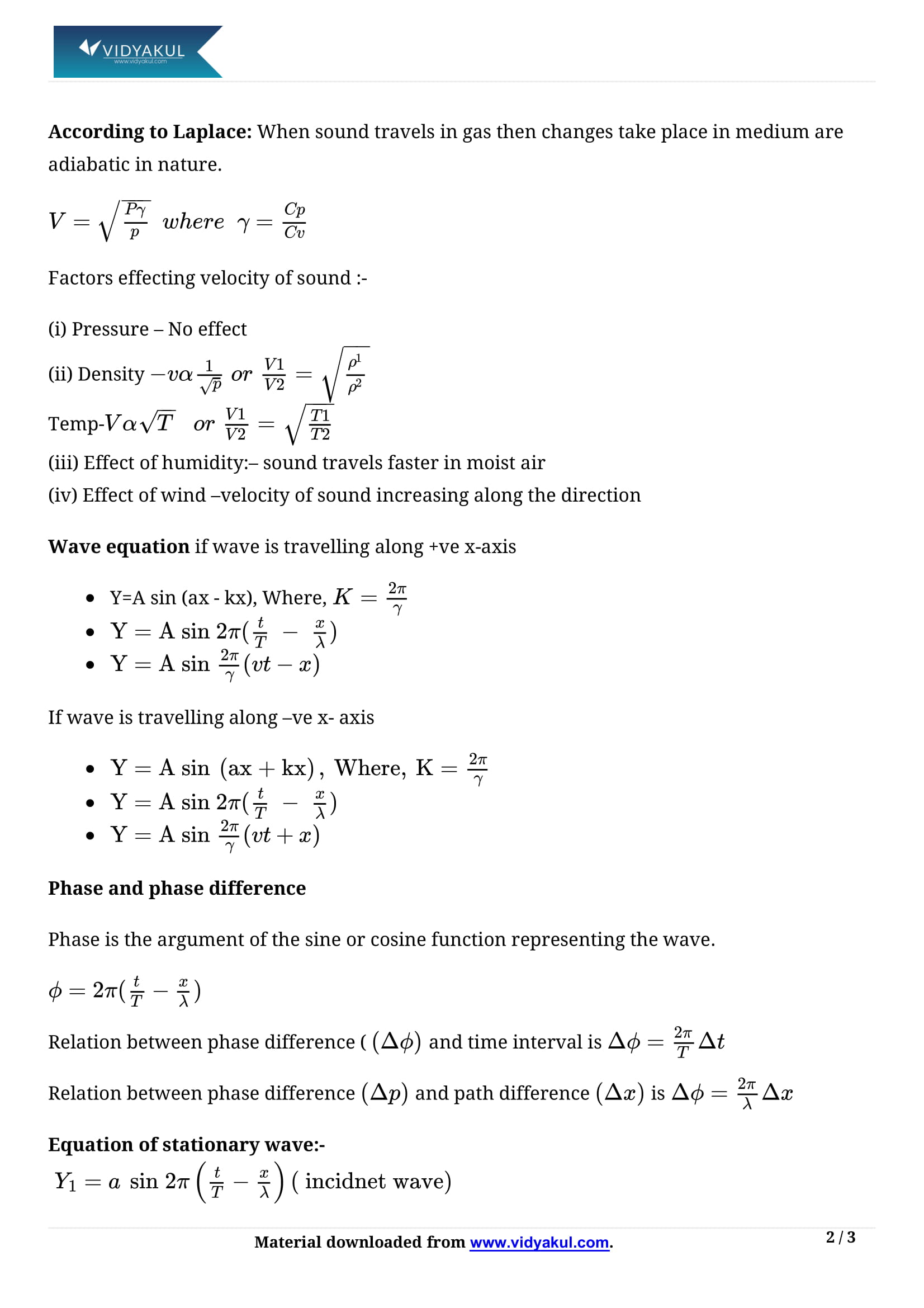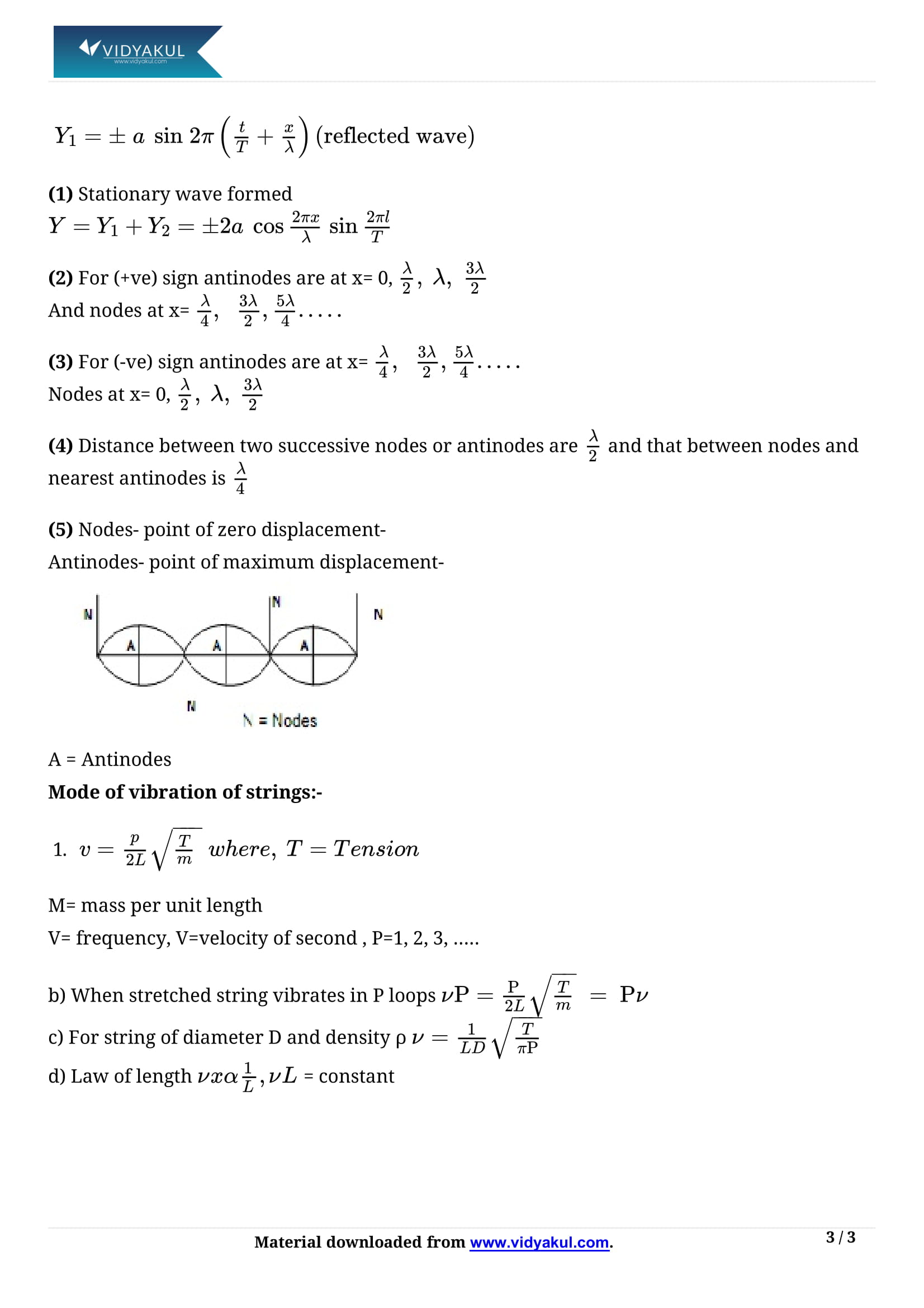Class 11 Physics Chapter 15 Waves Notes

Chapter 15 Waves
NCERT Physics Class 11 chapter 15 is about waves. 11th-grade students are required to study for the NCERT notes for the exam. These NCERT notes are designed according to the latest programs. Therefore, students can refer to it in preparation for the exam.
Vidyakul provides over 200 questions from over 20 of the best books for free. Students can practice these questions and get ahead of their competitors. Also, students can register on the platform and solve their problems. They will play an essential role in facilitating test preparation. Chapter 15 has some interesting subtopics. Thus, students can start preparing for the exam. Scroll down for more details.
CBSE CLASS 11th PHYSICS CH-15
Points to Remember
Given below are some crucial points to remember from Class 11 Physics Chapter 15:
A transverse wave is a wave motion in which the particles of the medium vibrate about their mean positions at the right angle to the direction of the propagation of the wave.
Wavelength is the distance between two successive particles of the medium which are in phase.
The velocity of sound in gases varies as directly proportional to the square root of the temperature of the gas.
Sound waves of a frequency of more than 20,000 Hz are known as ultrasonic waves.
The phenomenon of regular rise and fall in the intensity of sound, when two waves of nearly equal frequencies traveling along the same line and in the same direction superimpose each other is called beats.
Students can get more essential points on CBSE Class 11 Physics Chapter 15 at Vidyakul.
Topics and Sub-topics
Class 11 Physics Chapter 15 Waves will help you understand the propagation of waves in various media. We know that light can pass through a vacuum. Light from stars hundreds of light years away reaches us through the virtual vacuum of interstellar space.
This chapter introduces students to three types of waves: mechanical waves, electromagnetic waves, and matter waves. Mechanical waves are the most familiar because we encounter them all the time. Common examples include water waves, sound waves, and seismic waves. Students can start preparing for the exam by checking out Vidyakul. Wave is an important chapter to help students prepare for the exam. All of these learning materials are provided free of charge. These resources are a great way to thoroughly prepare for the exam.
Below is the list of topics included in CBSE Class 11 Physics Chapter 15:
Few Important Questions
What is a ‘traveling wave’?
A wave in which the positions of maximum and minimum amplitude travel through the medium is known as a traveling wave.
What is meant by the superposition of wave?
The superposition principle states that when two or more waves overlap in space, the resultant disturbance is equal to the algebraic sum of the individual disturbances.
What is meant by ‘time period’?
A time period is a time taken for one complete cycle of vibration to pass a given point.
Practice Questions
A string of mass 3 kg experiences a tension of 300 N. The stretched string’s length is 20 m. Calculate the time taken by the disturbance to reach the other end when one end is struck with a transverse jerk.
From a tower of height 400 m, a stone is dropped from the top into the water of the pond nearby. Calculate when the splash is heard at the top and the speed of sound in air is 340m/s (g=9.8 m/s2)
The length of the steel wire is 14 m and the mass is 3 kg. Find out the tension in the wire where the speed of the transverse wave on the wire equals the speed of sound in air at a temperature of 30 degrees= 353 m/s
A transverse wave is a wave motion in which the particles of the medium vibrate about their mean positions at the right angle to the direction of the propagation of the wave.
Wavelength is the distance between two successive particles of the medium which are in phase.
The velocity of sound in gases varies as directly proportional to the square root of the temperature of the gas.
Sound waves of a frequency of more than 20,000 Hz are known as ultrasonic waves.
The phenomenon of regular rise and fall in the intensity of sound, when two waves of nearly equal frequencies traveling along the same line and in the same direction superimpose each other is called beats.
What is a ‘traveling wave’?
What is meant by the superposition of wave?
What is meant by ‘time period’?
A string of mass 3 kg experiences a tension of 300 N. The stretched string’s length is 20 m. Calculate the time taken by the disturbance to reach the other end when one end is struck with a transverse jerk.
From a tower of height 400 m, a stone is dropped from the top into the water of the pond nearby. Calculate when the splash is heard at the top and the speed of sound in air is 340m/s (g=9.8 m/s2)
The length of the steel wire is 14 m and the mass is 3 kg. Find out the tension in the wire where the speed of the transverse wave on the wire equals the speed of sound in air at a temperature of 30 degrees= 353 m/s
Learn more about in Class 11 Physics Chapter 15 Waves Notes pdf.
Download this solution for FREE Download this PDF






